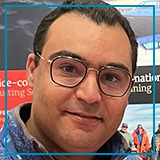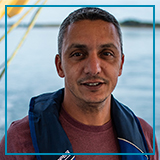
Prof. Fouad AMRAOUI
Full professor in Hydrology and Hydrogeology,
Head of «Géosciences Appliquées à l’Ingénierie de l’Aménagement» Research laboratory,
Faculté of Sciences Ain Chock,
Casablanca, Morocco.
Keynote Title : Water Governance in Coastal Areas: Challenges and Opportunities
Water is a key limiting factor in development, social peace, and prosperity. Its mobilization and good governance are essential for meeting the triple challenge of economic, social, and environmental sustainability.
Morocco has a coastline stretching 3,500 km along the Mediterranean and Atlantic. This coastline is home to cities, some of which are economic hubs, experiencing strong urban dynamics with an ever-increasing demand for water. This challenges managers to continuously strengthen water supply sources..
...
Coastal zones, with their relatively mild climate and high demand for food, are centers of sustained agricultural activity. This agriculture primarily draws its water needs from coastal aquifers, making these areas vulnerable to the encroachment of saline marine waters.
Over the last four decades, demographic growth, ambitious development projects, and the negative effects of climate change have forced Morocco to revise its governance approach and work towards a forward-looking vision. The new strategies for the rational management of water resources consider several factors, such as competing and multiple uses of water, legislative transitions, requirements for water availability and quality, and the needs of the environment and ecosystems. The use of unconventional water sources, such as desalination of seawater and reuse of treated wastewater, are becoming essential new resources, gradually establishing themselves as components in integrated water resource management. Water transfers between basins enable solidarity among regions for a better spatial distribution of water resources.
Morocco's water policy must align with the goals of the UN's 2030 Agenda for Sustainable Development, particularly SDG 6, which aims for universal and equitable access to water and sanitation. Meeting these challenges requires a combination of several concrete actions, among which are: prioritizing the right to drinking water and sanitation over other competing uses, increasing water efficiency and productivity, creating an environment conducive to change for the valorization of wastewater, developing synergy between public water policies and renewable energies, diversifying water sources, and meeting the needs for training competencies by introducing scientific and technological innovations.
The plenary conference aims to focus on water mobilization and management in Morocco's coastal zones and to outline the future prospects..
Read more

Prof. Maria Ana BAPTISTA
Instituto Superior de Engenharia de Lisboa and Instituto Dom Luiz,
University of Lisbon,
Lisbon, Portugal.
Keynote Title : Tsunami Warning Systems in the North East Atlantic and Mediterranean.
Two massive tsunamis marked the beginning of the 21st century: the Boxing Day tsunami in 2004 followed a magnitude 9.1 earthquake off the coast of northern Sumatra, Indonesia. This event was the worst tsunami in recorded history; it claimed more than 200,000 lives along the shores of the Indian Ocean. Seven years later, Japan recorded a magnitude 9.0–9.1 earthquake off the coast of Tohoku. The tsunami killed over 15000 people.
...
The Mediterranean hosted one of the deadliest tsunamis caused by the AD 365 Crete earthquake. Another major tsunami occurred in 1908 in Messina (Italy). The 2002 Stromboli (Italy) and 2003 Boumerdés (Algeria) caused minor damage recently. However, this was not true for the 2017 Kos-Bodrum or the 2020 Samos-Izmir events.
The North East Atlantic was home to two (confirmed) ocean-wide tsunamis in 1755 and 1761. In the 20th century, three earthquakes greater than magnitude seven occurred between Iberia and Azores (1941, 1969 and 1975).
Following the Indian Ocean in 2004, the IOC Member States requested the implementation of tsunami warning systems in the Indian Ocean (IOTWS), the Caribbean (CARIBE-EWS) and the North-Eastern Atlantic, the Mediterranean and Connected Seas Tsunami Warning and Mitigation System (NEAMTWS) similar to the Pacific Tsunami Warning System (PTWS).
Presently, the NEAMTWS (North Eastern Atlantic and Mediterranean Tsunami Early Warning System) operates seismic and tide gauge networks all over the basin that provide real-time data on seismic activity and sea level changes, enabling more accurate and timely tsunami warnings.
Despite the progress made since 2005, the system still needs to improve on faster seismic detection and data sharing, faster and more accurate tsunami forecasting, communication and information dissemination and public awareness and education.
Funded by the Fundação para a Ciência e a Tecnologia, I.P./MCTES through national funds (PIDDAC)” –UIDB/50019/2020-IDL
Read more

Prof. Lobna BOUDAYA
Full Professor,
Faculty of Sciences of Sfax,
Sfax University,
Sfax, Tunisia
Keynote Title : Engaging stakeholders in co-design and implementation of Nature-Based Coastal Protection in Tunisia- A case study from ORIENTATE Project.
Nature-based solutions (NbS) are increasingly recognized as effective alternatives to hard engineering methods for addressing coastal vulnerability. These approaches, characterized as nature-inspired and nature-supported solutions, offer numerous co-benefits and contribute to sustainable development goals. The interdisciplinary nature of NbS suggests that involving various stakeholders through collaborative approaches and dialogues is essential for successful planning, design, and implementation.
...
To explore the potential of NbS in coastal erosion prevention, the ORIENTATE project (Oceanographic and Ecological Data for Nature-based Coastal Protection) was conceived with two primary objectives: (i) Establishing a dynamic co-design laboratory that brings together stakeholders from diverse backgrounds and experiences. This collaborative environment aims to collectively brainstorm strategies for ensuring the success and long-term sustainability of NbS. (ii) Creating a pilot site within a marine ecosystem to assess the optimal conditions for seagrass transplantation. This pilot site also serves to evaluate the effectiveness of seagrass transplantation as an NbS approach for safeguarding the coast of Djerba Island against coastal erosion.
Within this project, we present two key aspects:(i) Stakeholder Perceptions, Preferences, and Perspectives, and (ii) an analysis of the participation process, which includes examining challenges and opportunities, motivations, and collaborative governance structures.
Our findings indicate that a bottom-up, stakeholder-led approach is the most suitable identified method for involving stakeholders. Collaborative planning is crucial for engaging stakeholders and fostering knowledge about NbS among stakeholders involved in the process.
Read more

Mr. Mohamed-Ali CHOUAER
Expert in marine geomatics,
Interdisciplinary Centre for the Development of Ocean Mapping (CIDCO),
Québec, Canada.
Keynote Title : Capacity Building and Hydrographic Training in Canada - The CIDCO's category B program in hydrographic surveying.
In 2022, the CIDCO (Interdisciplinary Center for the Development of Ocean Mapping) program “Course in Hydrographic Surveying” has been recognized for the second time by the International Board on Standards of Competence for Hydrographic Surveyors and Nautical Cartographers (IBSC) as a category B program under the “Standards of competence for Hydrographic Surveyors” S-5 Edition 11.0.1.
...
The CIDCO Course in Hydrographic Surveying is the only Cat-B program delivered both in French and in English in North America. The course is provided over a period of 40 weeks and it is composed of two main parts, which are the theoretical part and the Comprehensive Final Field Project (CFFP). The theoretical part of the course is given in an "e-learning" formula. The on-line platform we are using is among the best Learning Management System (LMS), it allows us to manage course activities and post course materials and electronic documents. This type of format makes the teaching resources and materials accessible to students any time from any computer anywhere in the world. In addition, this gives students the opportunity to complete the online activities in their own time without the same pressures as in-class activities. Over the past 7 years, 33 students from 18 different countries have completed the online program.
The CIDCO is committed to capacity building and our program provides the theoretical foundation and practical field experience that enables future hydrographers to execute hydrographic surveys, monitor and evaluate survey data quality in accordance with the newest IHO standards. Graduate students will be able to work as hydrographers on large survey operations such as nautical charting surveys, offshore surveys or on small survey units, utilized for ports, coastal engineering, inland waters and surveys launches in support of a large-scale survey operation.
Read more

Prof. Manuel Arcila GARRIDO
Full Professor,
Departamento Historia, Geografía y Filosofía,
Cadiz University,
Cadiz, Spain.
Keynote Title : Innovative proposals to evaluate the vulnerability and impact of climate change in coastal tourist destinations.
Tourism is a major global industry, attracting millions of visitors each year and contributing to local economic development. However, climate change poses challenges to the sustainability of coastal tourism, as extreme weather events can affect infrastructure and natural resources. In addition, it can also have a negative impact on coastal environments due to the fragility of these ecosystems and visitor overload.
...
Although climate is not the only motivating element for tourism, it can influence the final decision on the choice of one destination or another, especially in those destinations linked to specific typologies, such as winter sports-based or coastal-maritime tourism. Information on possible weather variations and their effects thus becomes an element in demand by tourists, but above all by tourism managers and public administrations who want to guarantee their profitability (economic and social) through the adaptation of the facilities that support the activity in the destinations. The maintenance of both tourist facilities and resources in the face of adverse meteorological phenomena represents a challenge in a panorama of growing uncertainty due to the already manifest effects of climate change. On the coast, the most relevant threat is the rise in sea level, but also others such as the increase in temperature, marine acidification or changes in meteorological waves and tides and the associated erosive processes. In this sense, the continued degradation and alteration of cultural and natural heritage due to climate will negatively affect the tourism sector, reducing the attractiveness of destinations and diminishing economic opportunities. Studies point to a number of medium and long-term effects that may occur on tourism activity as a consequence of global warming, which can be summarised as follows: Loss of market share worldwide (from 6% to 4.8% in 2030); Long-term reduction in the number of tourist arrivals (20% in 2080) and Relative loss of importance of coastal-maritime tourism as a tourism product due to the lack of climatic comfort in the summer months.
This talk will attempt to develop the relationship between blue tourism and climate change and the consequences on the society and economy of coastal tourist destinations.
Read more

Prof. Jean Luc MERCIER
Professor Emeritus,
University of Strasbourg,
Strasbourg, France
Keynote Title : From Tsunami to Turbidite: statistics & sedimentology, 80 Years of ambiguity.
Bagnold (1937) introduced the log-log description of granulometric distributions. Forty years later, Barndorff-Nielsen developed hyperbolic distributions. Fieller (1984) replaced this system with two linear equations. Most unimodal sediments must be described by skew laws, but a few can be described by the Normal Laplace Gauss law. These tools can be used to differentiate ebb or flood, uprush or backwash for tsunamis.
...
The evidence of multimodal Laplace-Gauss distributions in several tsunami deposits led us to develop an approach combining the concept of "self-suspension" (Bagnold, 1962) with the previous tools. This is the subject of this communication.
Read more

Prof. Papa SAGNE
Professor and Researcher,
Déepartement of Geology
Faculty of Sciences and Techniques
Cheikh Anta Diop University,
Dakar, Senegal.
Keynote Title : Capacity Building for Researchers on Coastal Dynamics Monitoring Methods for Better Management of Coastal Environments.
Coastlines are privileged sites for human settlements (homes, industries, ports, administration) and for tourism, transport and fishing activities, among others. Despite this great potential, these environments, ranked among the most evolving on the earth's surface are facing numerous challenges, including coastal erosion, which is recognised as one of the major risks threatening around 70% of the world's sandy coastlines.
...
Coastal erosion is a natural phenomenon that is currently being exacerbated by the sea level rise caused by climate change, as well as by human activities that sometimes disrupt the dynamic equilibrium of coastal areas. Good management of these environments requires in-depth knowledge of their geomorphological and sedimentological functioning.
Understanding coastal dynamics is a common concern for geomorphologists and coastal zone managers, and is based on several methods. These methods are function of the spatial and temporal dimensions considered, since the factors responsible for these dynamics vary both in time and space.
The aim of this presentation is to increase researchers' knowledge of the different methods used to study coastal dynamics and the advantages and limitations of each of them, depending on the time scale under consideration, in order to provide better support for decision-making.
.
Read more

Prof. Mouncef SEDRATI
Professor of Coastal Geomorphology and Marine Geology,
Director GO UBS,
Bretagne Sud University,
France.
Keynote Title : Microplastic contamination of coastal sediments – A large scale investigation.
An international review, currently nearing the final stages of publication, scrutinizes the issue of microplastic contamination in coastal sediments across the globe. Based on an extensive analysis of 131 studies from diverse regions, the review addresses multiple facets of this environmental concern.
...
It delves into the sources of microplastics, whether stemming from industrial activities or consumer waste, provides a comparative analysis of their abundance and distribution in various types of coastal sediments, categorizes the different forms of microplastics such as microbeads, fibers, and fragments, and also explores the eventual fate of these microplastics within coastal sediment ecosystems.
Read more










